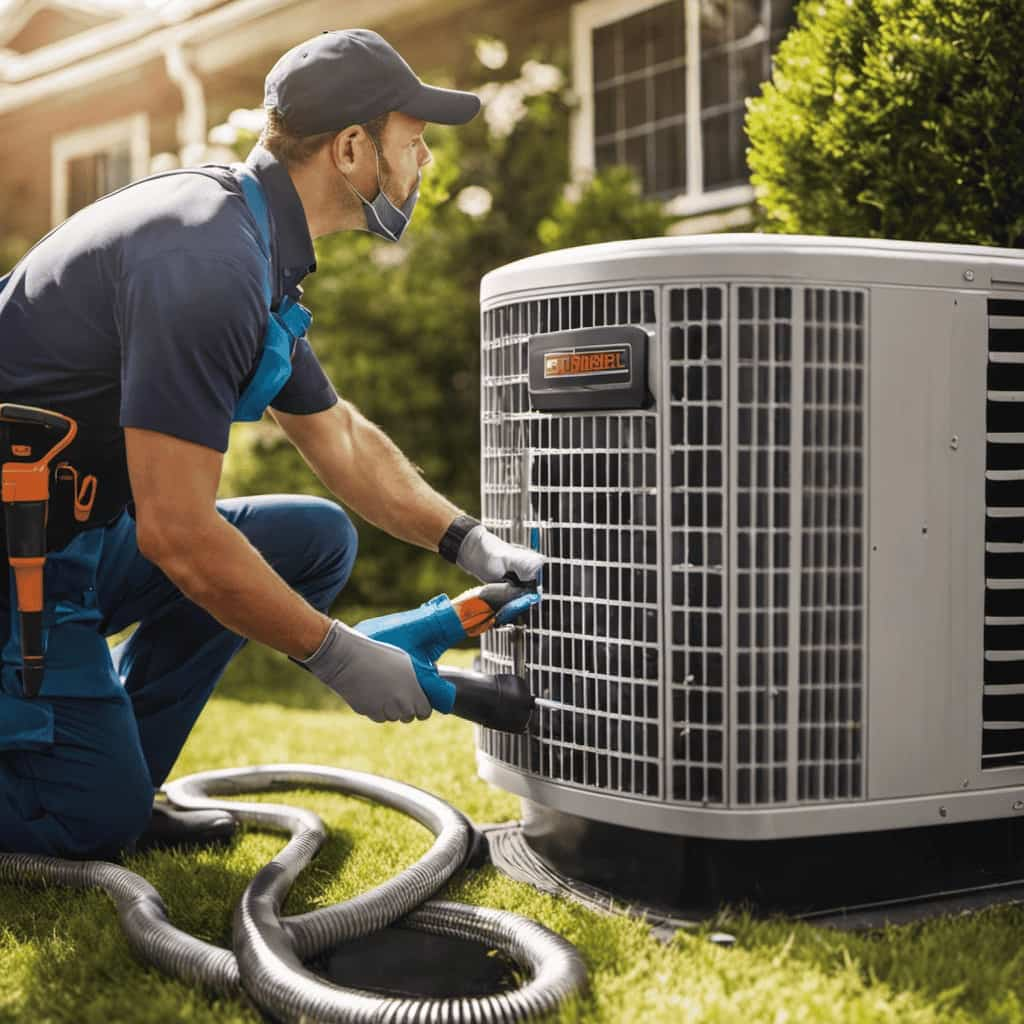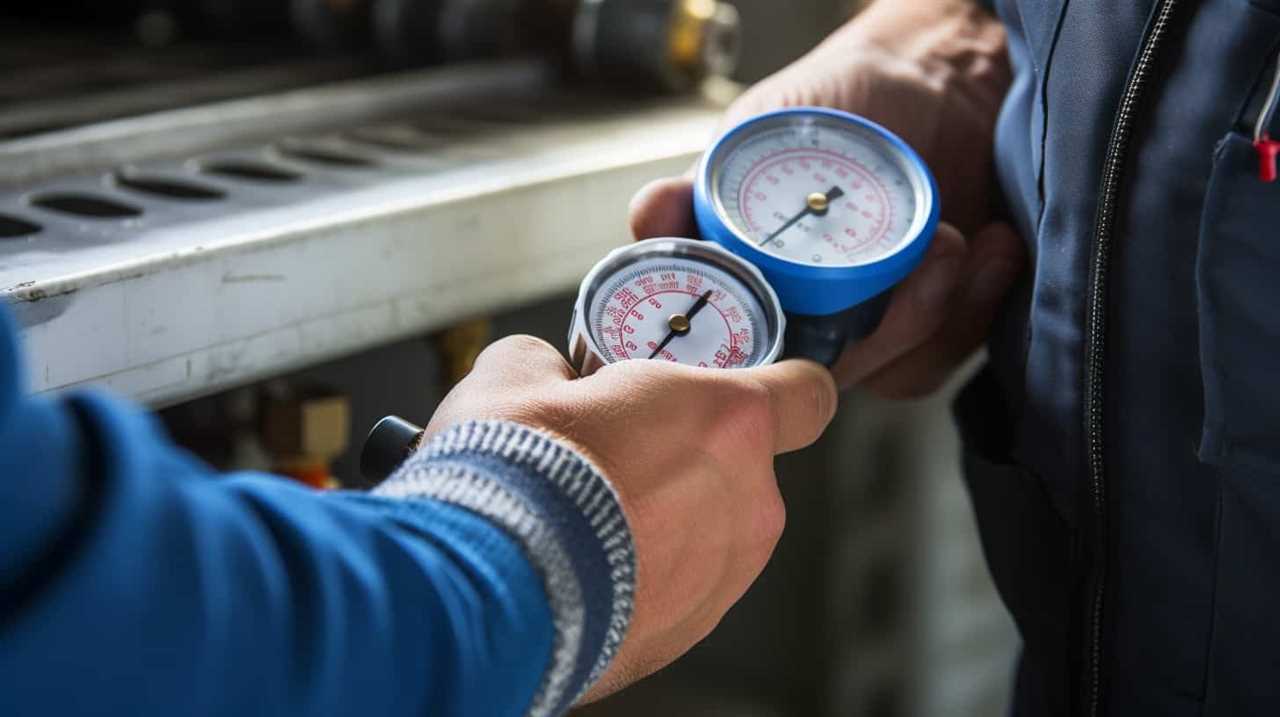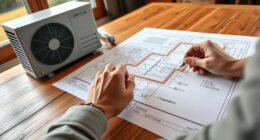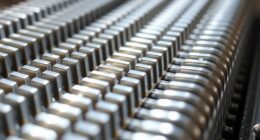Welcome to our investigation of the return on investment for energy-efficient heat pumps!
In this article, we will delve into the concept of ROI, evaluate the energy efficiency of heat pumps, and calculate the financial benefits they provide.
We will also examine the factors that affect the ROI of energy-efficient heat pumps and present real-life case studies to illustrate their impact.
Join us as we uncover the potential of these innovative solutions to revolutionize energy consumption and maximize returns.

Key Takeaways
- ROI is a crucial metric for analyzing investments and determining the financial value of energy-efficient heat pumps.
- Key performance indicators for evaluating energy efficiency include SEER, HSPF, and COP.
- Regular calculations provide potential cost savings and ROI.
- Energy savings impact ROI by reducing energy costs.
Understanding the Concept of ROI
We need to delve into the concept of ROI in order to fully understand the benefits of energy-efficient heat pumps.
ROI, or Return on Investment, is a crucial metric for analyzing investments and determining the financial value of implementing energy-efficient heat pumps in various settings.
By conducting a comprehensive cost analysis, we can assess the potential return on investment and evaluate the long-term benefits of energy-efficient heat pumps.
This analysis considers factors such as initial installation costs, energy savings, and maintenance expenses.

Understanding the concept of ROI allows us to make informed decisions regarding the adoption of energy-efficient heat pumps, ensuring that we maximize the financial and environmental benefits.
Evaluating the Energy Efficiency of Heat Pumps
To accurately assess the energy efficiency of heat pumps, we must evaluate key performance indicators such as Seasonal Energy Efficiency Ratio (SEER), Heating Seasonal Performance Factor (HSPF), and Coefficient of Performance (COP). These metrics provide valuable insights into the overall performance and energy savings potential of a heat pump system.
The SEER measures the cooling efficiency of a heat pump, indicating the amount of cooling output achieved per unit of energy input over an entire cooling season. The HSPF, on the other hand, reflects the heating efficiency of a heat pump and represents the ratio of heating output to energy input over an entire heating season. Lastly, the COP quantifies the ratio of heat output to energy input at a given point in time.
By evaluating these performance indicators, we can determine the energy efficiency and potential cost savings of a heat pump system, enabling homeowners and businesses to make informed decisions when it comes to adopting energy-efficient technologies.

| Performance Indicator | Description |
|---|---|
| Seasonal Energy Efficiency Ratio (SEER) | Measures the cooling efficiency of a heat pump over an entire cooling season. It indicates the amount of cooling output achieved per unit of energy input. A higher SEER rating signifies better energy efficiency and potential cost savings. |
| Heating Seasonal Performance Factor (HSPF) | Reflects the heating efficiency of a heat pump over an entire heating season. It represents the ratio of heating output to energy input. A higher HSPF rating indicates better energy efficiency and potential cost savings. |
| Coefficient of Performance (COP) | Quantifies the ratio of heat output to energy input at a given point in time. A higher COP value indicates better energy efficiency and potential cost savings. |
Calculating the Financial Benefits of Energy-Efficient Heat Pumps
By regularly calculating the financial benefits of energy-efficient heat pumps, we can determine the potential cost savings and return on investment for homeowners and businesses. Evaluating the cost effectiveness of heat pumps involves analyzing the long-term savings from using energy efficient systems. When assessing the financial benefits, it’s essential to consider factors such as energy consumption, utility rates, and maintenance costs.
To calculate the potential savings, one must compare the operating costs of an energy-efficient heat pump to that of a conventional system. By doing so, we can determine the payback period and the return on investment. Understanding the financial benefits allows homeowners and businesses to make informed decisions about adopting energy-efficient heat pump technology.
Now, let’s delve into the factors that can affect the return on investment of these systems.
Factors Affecting the ROI of Energy-Efficient Heat Pumps
Understanding the factors that impact the ROI of energy-efficient heat pumps is crucial for making informed decisions about their adoption. Several key factors can influence the return on investment of these heat pumps, including energy savings and the payback period.

Energy savings play a significant role in determining the ROI of energy-efficient heat pumps. These pumps are designed to consume less energy compared to traditional heating systems, resulting in reduced energy costs. The higher the energy savings achieved, the shorter the payback period, and the higher the ROI.
The payback period is another critical factor that affects the ROI of energy-efficient heat pumps. It refers to the time it takes for the energy savings generated by the heat pump to cover the initial investment cost. A shorter payback period indicates a higher ROI, making energy-efficient heat pumps more financially attractive.
To better understand the impact of these factors, let’s take a look at the following table:
| Factor | Description | Impact on ROI |
|---|---|---|
| Energy Savings | Reduction in energy consumption and associated cost | Positive |
| Payback Period | Time required to recover the initial investment | Negative |
Case Studies: Real-Life Examples of ROI on Energy-Efficient Heat Pumps
We’ll examine real-life examples to illustrate the ROI on energy-efficient heat pumps.

Real-life success stories are valuable in demonstrating the cost savings achieved through the implementation of energy-efficient heat pumps.
One such example is a residential building in a cold climate region that replaced its outdated heating system with an energy-efficient heat pump. A comprehensive cost savings analysis revealed that the building achieved a 40% reduction in heating costs, resulting in significant financial savings.
Another case study involved a commercial facility that upgraded its HVAC system to energy-efficient heat pumps. By doing so, the facility experienced a 30% decrease in energy consumption, leading to substantial cost savings.
These real-life examples demonstrate the tangible benefits and return on investment that can be achieved through the adoption of energy-efficient heat pumps.

Frequently Asked Questions
Are There Any Government Incentives or Rebates Available for Installing Energy-Efficient Heat Pumps?
Yes, there are government incentives and rebates available for installing energy-efficient heat pumps. These incentives aim to promote the adoption of greener technologies and can help offset the initial costs of installation.
How Long Does It Usually Take to Recoup the Initial Investment in Energy-Efficient Heat Pumps?
We found that the time it takes to recoup the initial investment in energy-efficient heat pumps varies based on factors such as energy prices, installation costs, and the efficiency of the system. However, with the potential cost savings, geothermal heat pumps can be a worthwhile long-term investment.
What Are the Maintenance and Repair Costs Associated With Energy-Efficient Heat Pumps?
Maintenance and repair costs for energy-efficient heat pumps can vary depending on factors such as the size of the system and the complexity of the repairs needed. It’s essential to budget for these expenses to ensure long-term efficiency and savings.
Are There Any Potential Drawbacks or Limitations to Using Energy-Efficient Heat Pumps?
There are potential disadvantages to using energy-efficient heat pumps, such as their performance in extreme temperatures. However, their benefits in terms of energy savings and environmental impact make them a promising innovation for the future.

How Does the Climate or Geographical Location Affect the ROI of Energy-Efficient Heat Pumps?
The climate and geographical location can significantly impact the ROI of energy-efficient heat pumps. Factors such as temperature, humidity, and energy costs all influence the potential energy savings and financial benefits of installing these systems.
Conclusion
In conclusion, investing in energy-efficient heat pumps can result in significant financial benefits due to their higher energy efficiency.
By understanding the concept of ROI and evaluating the energy efficiency of heat pumps, it becomes clear that these systems can provide a substantial return on investment.
Factors such as energy savings, government incentives, and reduced maintenance costs all contribute to a positive ROI.

With real-life case studies showcasing the impressive returns, it’s safe to say that energy-efficient heat pumps are a wise and lucrative choice.









